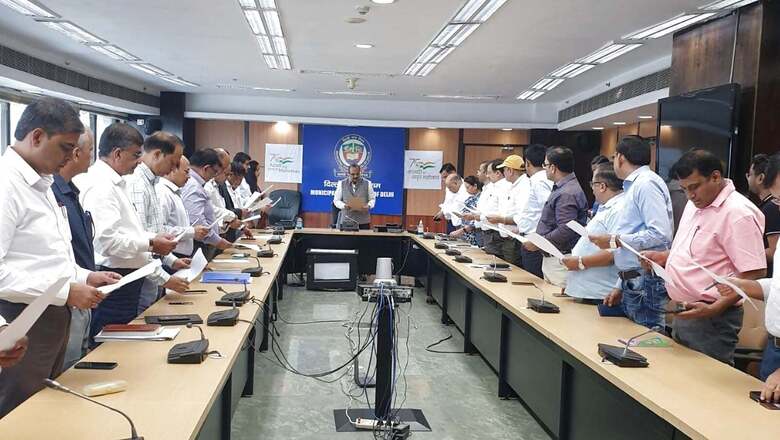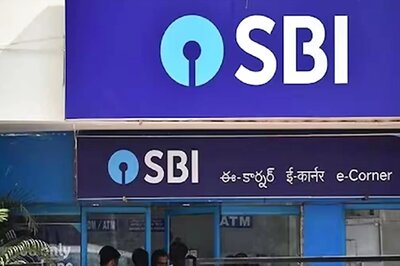
views
Parties are pulling out all stops to emerge victorious in the MCD polls slotted to take place on December 4. The will be tallied on December 7, and political bigwigs AAP, BJP and Congress are in the fray. Other parties like BSP and AIMIM (in alliance with ASP) are also contesting the elections, eager to win in the national capital.
Earlier this year, Delhi’s civic bodies were merged in May, and the civic map of the nation’s capital was formally redrawn.
The Delhi Municipal Corporation (Amendment) Bill, 2022, which combined the East, North, and South municipal corporations of Delhi into one Municipal Corporation of Delhi, was passed by the Union government earlier this year despite opposition from the city’s ruling Aam Aadmi Party (AAP) and other opposition parties.
As the polls draw near, News18 explains why the move was carried out and what impact it had on MCD’s functioning:
- According to a report by India Today, there was a mention of the existence of a municipality in 1862 in Delhi. On April 23, 1863, the municipality had its first regular meeting to which local residents were invited. The Commissioner of Delhi presided over the meeting on June 1, 1863.
- On April 7, 1958, a Parliamentary Act formed the Municipal Corporation of Delhi. Prior to that, Delhi’s main civic organisation was the DMC (Delhi Municipal Committee).
- From 1866 until late 2009, the MCD’s offices were located at Chandni Chowk in Old Delhi at the Delhi Town Hall, before moving to the new MCD Civic Centre on Minto Road in Central Delhi.
- The report states that there was a time when the Joint Water and Sewerage Board, Delhi State Electricity Board, and Delhi Road Transport Authority used to come under the corporation. However, a Road Transport Corporation was established in November 1971 as a result of a Parliamentary Act that separated the Delhi Transport Institute from the Municipal Corporation of Delhi.
- Then, a 1993 amendment in the existing Act brought about fundamental changes in composition, functions, governance and administration of the corporation.
- The Municipal Corporation of Delhi was split into three corporations in 2011 by altering the Municipal Corporation of Delhi Act: North, South, and East Delhi Municipal Corporations, with 104 awards given to the first two, and 64 to the latter.
- A new zone, Keshavpuram, was also created as a result of the delineation done prior to the 2017 elections in order to maintain balance in the regional offices of the North Delhi Municipal Corporation, while the urban and Sadar Paharganj zones were combined to form the City-SP zone.
- Over the years, trifurcated MCDs have encountered a number of issues, including the failure to pay the salaries of safai karamcharis (sweepers), the unequal allocation of property taxes among the three civic organisations, ineffective management, and increasing losses, among others.
- Uneven Division: In terms of the territorial divisions and the potential for each corporation to generate revenue, the trifurcation was uneven. As a result, there was a vast disparity between the three firms’ available resources and their duties.
- Widened Gaps: The gap has grown over time, making it more difficult for the three municipal corporations to pay their employees’ salaries and retirement benefits on time. As a result, Delhi’s ability to maintain its civic services was said to be severely hampered.
- The entire city, with the exception of a few isolated areas in Lutyens’ Delhi and the cantonment, was brought under one body, ending the old limits of civic bodies.
- The second phase would have been to unify the workforce, which is anticipated to not have impacted lower-level personnel but would have decreased up to a third of senior roles, according to The Indian Express, which would have lowered redundancy and salary costs.
- “For example, there will be one director for each department such as horticulture, sanitation, education, health, hospital, etc. in the unified corporation instead of the existing three directors, one for each of the three MCDs. The same will apply to commissioners, committee heads, and mayors,” the IE report had stated.
- A former director of the North MCD’s press and information wing Yogendra Singh Mann told The Indian Express that there would first be a balance between resources, income, and expenses with the unification. North wing had experienced salary delays on a regular basis. There will be uniformity following the merger, he had said.
- A centralised authority for items like parking fees, property taxes, and new city projects would also improve civil planning, according to Mann.
- According to an article in India Today, settling the power struggle between elected politicians and officials would also be a goal of the merger, along with offering the MCD a bailout package to pay down its backlogs as the North and East MCDs had been losing money. “Through MCD unification, the Centre might chip in to bailout the MCD by providing one-time package to clear the backlogs occurred so far. Due to this crisis, employees are unable to get salaries on time and most of the times they have to wait for months to get their salaries,” he had said.
- In May, the Centre named Gyanesh Bharti as the united MCD’s commissioner and IAS officer Ashwani Kumar as its special officer.
- Then, according to PTI at the time, the exercise to restructure and reorganise the municipal workforce started.
- Civic bodies in the South, North, and East saw their terms expire in May. Following the delimitation process, the special officer and commissioner took over the positions of elected council members and municipal committees.
- According to a report by the Indian Express in October 2021, sources in the BJP had told the publication that advocating for a merger also had political connotations as the MCDs have constantly been devoid of funds because the ‘AAP-led Delhi government is blocking it’.
- “This would also help the party send out a message to the public of how they plan to fix the fund crisis if voted to power again,” a leader had been quoted as saying.
- The Delhi BJP has long called for the corporations to be combined. It was brought up in 2014 and 2017 when Vijay Goel, a former union minister, said that unification would improve functioning.
Read all the Latest Explainers here



















Comments
0 comment